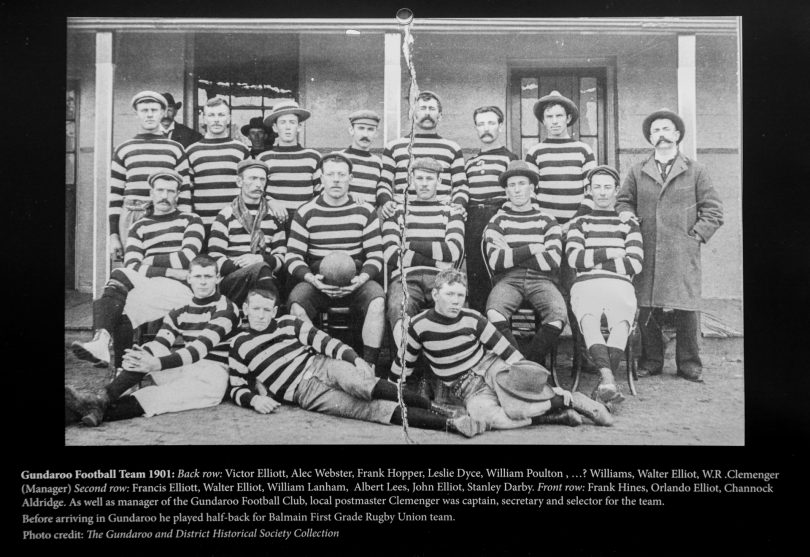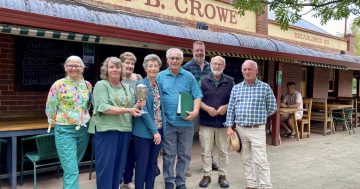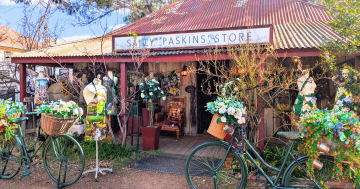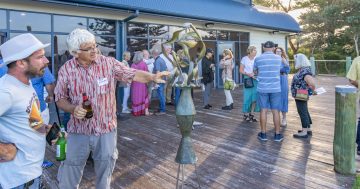
Portrait of the Reid family children – Margaret, Thomas, Lillian and Aimee. Photo: The family of Richard and Sarah Reid.
History is everything in a village like Gundaroo. It explains its past and, if you’re lucky, helps direct its future.
For a small village on Canberra’s outskirts, Gundaroo has an impressive history. You can still see much of it in its 19th-century slab houses, long narrow blocks so the night carts had easy access down the back, the fact there is still a Gundaroo Literary Institute and even some of the same names on mailboxes that have changed little in 100 years.
Having such a background provides great fodder for the village’s historical society according to its president Sue Burns, especially when it comes to producing its annual calendar – and main source of fundraising.
The 2022 calendar, which has just been released, records the best of the village – its buildings, its people, early street scenes and even the place where everyone ended up – the village cemetery.
It also shares little known facts like the number of lives the Gundaroo Soldiers’ Memorial Hall had – one of which was the Elite Roller Skating Rink in 1890.
Recent building renovations revealed a treasure trove of early ephemera, ranging from tickets for when it showed moving pictures, to self-publicising visiting entertainers with interesting names: “The Sloggetts. 3rd visit. 28/4/39”, “T. Dunsanson. Comedian. Coming. Again”, or “The Night of nights, at Gundaroo, 14-10-38” signed by an H. Brennan.
The Gunning Revellers also made their mark – it looks like on the wall, with the date of their appearance on what was clearly a big night, also 14-10-38.
Back in 1975, the National Trust commissioned a report, the Township of Gundaroo, designed to both document the village’s past and assess its future development.
It features photographs of original buildings in the village, those that have been changed and those that no longer look like they once did – some of which Sue Burns said, have been used in the calendar.
They include past and present images of the street view entering the village from the north when there were only a few dozen houses.
The images also show how flexible the village was in its heyday, like St Mark’s Church which was actually built as the Gundaroo Court House in 1875.
Five years later, part of the building was used for Gundaroo’s telegraph station and later again, as a school.
In 1940, the calendar tells us, it was sold to the Church of England for the princely sum of 460 pounds and after being renovated with new arches, it was dedicated as St Mark’s on 13 July, 1941.
Sue Burns said the historical society also had a good collection of early Gundaroo images which had either been donated to the group or collected by members over the years.
“We probably have a few hundred images in our collection,” Sue said. “Many of them have been donated which is wonderful.”

The Gundaroo football team circa 1901. As well as being manager of the club, local postmaster W.R. Clemenger (in coat) was also captain, secretary and team selector. Photo: The Gundaroo and District Historical Society Collection.
One of the Historical Society’s own images which also features in the calendar, shows the Gundaroo football team circa 1901.
It’s a fierce shot of stern-looking men, some wearing hats but all wearing frowns, except for an even sterner man in a long coat, and almost as long moustache, wearing striped jumpers that would not look out of place in a penal institution.
But the star of the photo would have to be one W.R. Clemenger who apparently played halfback for Balmain’s first-grade rugby union team. He also was the captain, secretary and selector for the Gundaroo team.
One of the most poignant photographs in the calendar is on loan from the family of Richard and Sarah Reid.
It’s a portrait of the Reid family children, a stunning image that hides the saddest of stories.
The four children pictured – Margaret, Thomas, Lillian and Aimee – were the children of Richard and Sarah Reid (nee Rich) from Spring Flat, Tallagandra. Tragically, Thomas and his parents Richard and Sarah died within three days of each other from pneumonic influenza in 1929. They are buried in the Gundaroo cemetery.
The calendar is the Gundaroo Historical Society’s main fundraiser for the year and costs $15 or $18 posted.
All money raised goes to help the Gundaroo Historical Society continue to ensure the village’s history remains alive.
The society also welcomes donations of early photographs of the village and its people to add to its collection.
For more information and to order a calendar, email [email protected]














